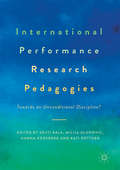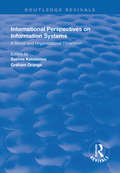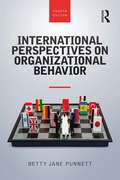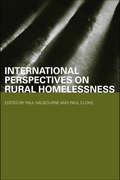- Table View
- List View
International Performance Research Pedagogies
by Milija Gluhovic Sruti Bala Hanna Korsberg Kati RöttgerThis book offers a unique and much-needed interrogation of the broader questions surrounding international performance research which are pertinent to the present and the future of Theatre and Performance studies. Marking the completion of eight years of the Erasmus Mundus MA Programme in International Performance Research (MAIPR) - a programme run jointly by the universities of Warwick (UK), Amsterdam (Netherlands), Helsinki/Tampere (Finland), Arts in Belgrade (Serbia), and Trinity College Dublin (Ireland) - the essays in this volume take stock of the achievements, insights and challenges of what international performance research is or ought to be about. By reflecting on the discipline of Performance Studies using the MAIPR programme as a case study in point, the volume addresses the broader question of the critical link between the discipline of Performance Studies and humanities education in general, examining their interactions in the contemporary university in the context of globalisation.
International Perspectives on Age-Friendly Cities (Routledge Studies in Human Geography)
by Kelly G. Fitzgerald Francis G. CaroThis book brings together recent scholarly work concerned with efforts around the world to transform cities so that they are more age-friendly. Common to all of the initiatives is recognition of the importance of the community environment for the well-being of the rapidly growing numbers of older people. The collection includes chapters that examine the circumstances in which communities currently undertake significant age-friendly initiatives, public-private collaboration in age-friendly initiatives, collaboration across institutional sectors in age-friendly initiatives, policies that facilitate age-friendly developments, and the bases upon which age-friendly initiatives should be evaluated. It will be of interest to scholars in various fields including urban planning, gerontology, transportation planning, environmental design, and adult education.
International Perspectives on CLIL (International Perspectives on English Language Teaching)
by Darío Luis Banegas Chantal HemmiThis edited book offers culturally-situated, critical accounts of Content and Language Integrated Learning (CLIL) approaches in diverse educational settings, showcasing authentic examples of how CLIL can be applied to different educational levels from primary to tertiary. The contributors offer a research-based, critical view of CLIL opportunities, challenges and implications in the following areas: teacher education, continuing professional development, assessment, teacher-student dialogue, translanguaging, coursebooks, bilingual education, authenticity, language development and thinking skills. This wide-ranging volume will appeal to students and scholars of English Language Teaching (ELT), language policy and planning, bi- and multilingualism, and applied linguistics more broadly.
International Perspectives on Critical Pedagogies in ELT (International Perspectives on English Language Teaching)
by Mario E. López-GoparThis edited collection brings to the forefront attempts to connect critical pedagogy and ELT (English Language Teaching) in different parts of the world. The authors in this collection write from their own experiences, giving the chapters nuanced understanding of the everyday struggles that teachers, teacher educators and researchers face within different contexts. Throughout the book, contributors connect micro-contexts (classrooms) with macro-contexts (world migration, politics and social issues) to demonstrate the impact and influences of pedagogy. In problematizing ELT and focusing on so-called ‘peripheral’ countries where educators have created their own critical pedagogies to respond to their own local realities, the contributors construct ELT in a way that goes beyond the typical ESL/EFL distinction. This unique edited collection will appeal to teacher educators, in-service teachers working in the field as well as students and scholars of English language teaching, second language acquisition and language education policy.
International Perspectives on English Private Tutoring: Theories, Practices, and Policies (International Perspectives on English Language Teaching)
by Anas Hajar Kevin Wai Ho YungThis book focuses on private tutoring (sometimes also known as “shadow education”), an important but neglected topic in applied linguistics and language education research. Private tutoring has become a popular out-of-school learning activity worldwide. While its scope and definition are expanding, private tutoring commonly refers to the “paid service students used to supplement their learning of academic subjects at school outside school hours” (Yung, 2019). Around the world, English language is one of the most popularly enrolled subjects in private tutoring, including both English as a first language and English as an additional language (EAL). Despite its popularity and implications for theories, practices, and policies, research on English private tutoring is still in its infancy. This book aims to provide an international perspective on the interface between applied linguistics and comparative education and open up an agenda for discussion in theories, practices, and policies in English language teaching (ELT). It will be of interest to students, scholars, and policy-makers in these and related areas.
International Perspectives on Ethical Educational Leadership: Lessons from Workplace Cultures That Have Lost (and Found) Their Way
by Brandy Yee Dianne YeeThis book considers ethical educational leadership dilemmas that impact the workplace cultures influencing school districts' success. As school systems become increasingly demographically, racially, and culturally diverse, the need intensifies for educational leaders to lead their school communities in an ethical manner, developing workplace cultures characterized by psychological and emotional safety. Based on research and extensive experience working with school districts in Canada, Germany, Finland, and the United States, Yee and Yee deliver vignettes from various school contexts illustrating ethical leadership dilemmas and leader responses indicative of both toxic and healthy workplace cultures. Finally, the authors present key lessons learned from healthy educational workplaces, illustrating next steps and a call to action for implementing and maintaining ethical school district leadership practices.
International Perspectives on Exclusionary Pressures in Education: How Inclusion becomes Exclusion
by Elizabeth J. Done Helen KnowlerThis book examines and problematises the concept of 'educational inclusion' within schools. Despite varying definitions of inclusion according to national context, there is a growing consensus that educational systems presented as ‘inclusive’ in policy and professional discourse, in practice, legitimise processes that appear far from inclusive. The editors and contributors draw together research from multiple contexts that considers systemic exclusionary pressures and practices from multiple perspectives, particularly less visible forms of social and educational exclusion. The book calls for true inclusion as an overriding socio-political and educational policy objective, and to end the marginalisation of specific groups beyond familiar neoliberal political discourses of piecemeal remediation.
International Perspectives on Financing Higher Education
by Wojciech Bienkowski Josef C. Brada Masaaki KuboniwaHigher education is increasingly important to the labor market success of individuals and the prosperity of nations, yet, as this book shows, public funding for higher education is declining. It presents innovative approaches to increasing funding for universities through closer ties with business and through privatization of universities.
International Perspectives on Information Systems: A Social and Organisational Dimension (Routledge Revivals)
by Savvas Katsikides Graham OrangeFirst published in 1998, this book addresses the increasingly important social and organisational issues of information systems development both at the operational level and within a wider social context. Reflecting the environmental issues surrounding the development of information systems and the implementation of information technology. This book is aimed at supporting information systems courses incorporating a behavioural element or sociology courses with an information systems content.
International Perspectives on Intimate Partner Violence: Challenges and Opportunities (AFTA SpringerBriefs in Family Therapy)
by Sandra M. Stith Chelsea M. SpencerThis book examines international perspectives on intimate partner violence (IPV). It highlights the current state of IPV prevention and intervention efforts across countries, including Colombia, Iran, Russia, China, India, Turkey, Nigeria, the United Kingdom, Finland, and the United States. The book examines the countries of origin in context (e.g., population, area, religion, ethnic diversity) and includes current rates of IPV in each country. In addition, it addresses growth areas and challenges regarding IPV prevention and intervention, including legal issues as well as cultural and social contexts and their relation to IPV – and the clinical interventions used – within each country. The book discusses challenges and opportunities for growth and seeks to gain a more robust and systemic perspective on the global phenomenon of IPV. It examines how larger social, cultural, and global factors affect the lives of the individuals whom family therapists serve and advocate for as well as provide guidance for culturally appropriate clinical and prevention practices. Key areas of coverage include: · International perspectives on intimate partner violence. · Intervention and resources available for victims of intimate partner violence. · Policies and laws relating to intimate partner violence. International Perspectives on Intimate Partner Violence is an essential resource for clinicians, therapists, and practitioners as well as researchers, professors, and graduate students in family studies, clinical psychology, and public health, as well as all interrelated disciplines.
International Perspectives on Language and Work: Analysing the Impact of Mutual Influences
by Stéphanie Cassilde Adeline GilsonThis volume expands the definitions of language and work in researching their mutual influences. It considers language as a working tool, a vector of occupational identity, and so on, and work as the needed daily interrelation tasks, communication constraints and so on. The volume covers various national contexts: India, France, Argentina, Morocco, Portugal, Palestine, Brazil, Singapore, and Canada. The diversity of countries and linguistic spaces presented here enriches the perspectives in terms of transferring the insights from one situation to another. The specific cases discuss, among others, how an occupation may be structured by language use; how language embeds occupations within certain social contexts; challenges of teaching in multilingual classrooms; and how language affects therapeutic discourse and communication between patients and doctors. The chapters provide detailed contexts and backgrounds so that readers can enjoy entering into each context and seeing similarities and differences with their own research field to incorporate the findings into their own research. This volume is intended for sociologists interested in professionalisation, industrial and occupational sociology, sociology of work, public health, and management research.
International Perspectives on Migration, Bullying, and School: Implications for Schools, Refugees, and Migrants (Routledge Research in Crises Education)
by James O’Higgins Norman Hildegunn FandremThis edited volume consolidates research from 32 countries in order to address the implications of the recent global wave of migration on educational opportunity and assess links between migration and bullying in Europe and further afield.Using data gathered from the European Commission-funded TRIBES project (Transnational Collaboration on Bullying, Migration, and Integration at School Level), chapters cover first-hand accounts, policy document analysis, and lived experience through comparative themes such as school climate, governmental policy, diversity and inclusion, technology, student voice, and school design to demonstrate how bullying can be understood as a threat to developing inclusive and diverse schools and societies globally. Rooted in a bio-ecological model that recognizes the intersectionality of migrant lives, ultimately this book will advance collaboration between stakeholders to ensure better integration, a reduction in bullying, and better safety and well-being for refugee and migrant students.Reflecting the truly cross-disciplinary, cross-cultural, and intersectional nature of the volume, this book will be of interest to researchers, scholars, and postgraduate students in migration and education studies, bullying and cyberbullying, and the sociology of education. Policymakers and practitioners in psychology, technology, and youth studies more broadly will also benefit from this book.
International Perspectives on Organizational Behavior
by Betty Jane PunnettThe book examines the international, cross-cultural environment faced by international firms, detailing how this environment affects behavior at both the individual and organizational levels. Fully updated to incorporate the latest research in the field, Punnett has also invested in several new features that will make this book even more appealing to students and instructors: Expanded and new coverage of several key topics, including diversity, multi-cultural teams, virtual teams, global careers, global talent management, global value chains, ethics, and millennials. New pedagogy—learning objectives, chapter summaries, lessons learned, cases, mini-cases, and discussion questions—to help students consolidate learning and encourage critical thinking. Clearly written and concise, International Perspectives on Organizational Behavior helps students of international organizational behavior and cross-cultural management classes understand the many differences that managers face when operating cross-nationally, and provides them with practical tools to tackle these differences.
International Perspectives on Parenting Support and Parental Participation in Children and Family Services (Routledge Advances in Social Work)
by Carmel Devaney Rosemary CrosseThis book provides an account of parenting support initiatives in children and family services from a number of jurisdictions, paying particular attention to their impact on both ‘hard’ and ‘soft’ outcomes for participants and to the inclusion of parents in the design and delivery of these supports. By focusing on parents who are experiencing challenges outside of the normal day-to-day task of parenting and in receipt of formal support services, their perspectives on the experience of receiving these supports and the difference experienced by children and family members are analysed. Conceptually driven and reflecting the individual theories and frameworks that underpinned the parenting supports, the participatory processes and the research undertaken, this book includes case studies from Australia, Bulgaria, England, Italy, Ireland, Northern Ireland, Norway, Poland, Portugal, Scotland, Serbia and Spain. By highlighting the theoretical, conceptual and practical considerations required when supporting parents in an inclusive manner, it will be of interest to all scholars, students and practitioners working in the following areas: social work and social care, child development, child protection and social policy.
International Perspectives on Racial and Ethnic Mixedness and Mixing (Relationships and Resources)
by Rosalind Edwards Miri Song Suki Ali Chamion CaballeroPeople from a ‘mixed’ or ‘inter’ racial and ethnic background, and people partnering and parenting across different racial and ethnic backgrounds, are of increasing political, public and intellectual interest internationally. Contributors to this interdisciplinary collection interrogate notions of mixedness and mixing, and challenge stereotypical assumptions. They advance debates in the field through illuminating the complexity of specific historical trajectories, administrative practices and lived experience. Recurrent themes woven throughout the chapters include: boundaries and categorisation in terms of administration and government, and also of lived experience the explicit and implicit politics of mixedness and mixing in terms of nation state interests, agenda and policies, as well as ‘on the ground’ social relations the ways that mixedness and mixing shift in meaning and implications across time and place, shaped by different national, regional and or local contexts. This volume shows that who is and is not ‘mixed’ is contested and understandings of mixedness and mixing, however conceived, need to be situated in the larger complex of ideas about race and its classification. International Perspectives on Racial and Ethnic Mixedness and Mixing is an invaluable book for students and scholars of race and ethnicity.
International Perspectives on Research in Educational and Career Guidance: Promoting Equity Through Guidance (Springerbriefs In Education Ser.)
by Barrie A. Irving Beatriz Malik-Liévano Beatriz Álvarez-González María Fe Sánchez-GarcíaThis book discusses the scientific developments on the new roles of interventions in career-and-life design (career education, career counseling, etc.) regarding the world's main challenges. Thanks to the strong partnership between the UNESCO Chair and partners ECADOC (European Doctoral Program on Career counseling and Guidance) and ESVDC (European Society for Vocational designing and Career counseling), this book represents a strong collection of models, scientific proposals and analyses of practices and interventions by scholars from all different parts of the world. It provides a large overview of current research in the field of Interventions for Life and Career Design (ILCD) in Northern and Southern countries, and calls for increased responsibility of individuals, groups and communities to design their life and their individual and collective future.
International Perspectives on Rural Homelessness (Housing, Planning and Design Series)
by Paul Cloke Paul MilbourneDrawing on recent academic studies in North America, Europe, Australia and New Zealand, this book is the first international text on homelessness in rural areas. Consisting of fifteen specially commissioned chapters, International Perspectives on Rural Homelessness provides comparative material on the cultural, political and policy contexts of rural homelessness, examining the nature and scale of the issue and the complex local geographies of rural homelessness.
International Perspectives on School-University Partnerships: Research, Policy and Practice
by Ondine Jayne Bradbury Daniela AcquaroThis book draws together international scholarship on school–university partnerships challenging thinking about purpose and sustainability as well as the power of collaboration in transcending organisational and contextual boundaries. Moving beyond transactional arrangements, the book showcase various models of school–university partnerships, and explores the role of policy, research, and practice, across the life cycle of partnerships. This edited collection presents a strong body of evidence with global significance, providing valuable insights into catalysts for partnerships, the drivers for transformational change, and generative growth resulting from authentic collaboration. An important reference for all teacher education providers, schools, and educational stakeholders, this book showcases global examples of the power of partnerships in an era necessitating cross sectoral collaboration to address contemporary societal challenges.
International Perspectives on Sport for Sustainable Development
by Claude Sobry Kazem HozhabriThis book brings together examples and cases from across the world to discuss how sport has and can further contribute to the UN 2030 Sustainable Development agenda. It discusses the major steps that international bodies have taken so far and can further take in the progressive integration of sport for sustainable development. Contributors from 21 countries take up at least one of the 17 UNO Sport for Development and Peace goals, and present and analyse examples of national, regional or local policies using sport as a lever for sustainable development. From traditional games to major competitions, from gender equality to social development and developing governmental transparency, the chapters showcase diverse experiences and demonstrate that sport is today much more than just physical activity. This book is based on the network of the International Research Network in Sport Tourism (IRNIST) with the collaboration of Sport 4 Impact. It is the first step of a collaboration between universities and the world of associations working in partnership with organizations such as the UN or the European Union. The book is an important resource not just for students and researchers of sport science but for policy makers, bureaucrats and sport administrators.
International Perspectives on Suburbanization
by Nicholas A. PhelpsThe road to and from the airport in many national settings presents a seemingly familiar sight. Typically congested roads allow the observer to register new urban developments such as office blocks, warehouses, retail complexes with gated residential developments often in close attendance in configurations that appear common throughout the world. In the United States these developments have prompted new terms such as 'edge city', 'edgeless city' and 'technoburb' in an attempt to signal a break with processes of urbanization that produced traditional residential suburbs. In posing the question of whether we live in a distinctly post-suburban world, this book is the first systematic attempt to explore the salience and nature of processes post-suburbanization in international perspective. Drawing on thematic chapters covering the history, form and politics of contemporary urbanization and on examples from the Americas, Europe and Asia the book elaborates on the manner in which contemporary developments in the outer reaches of city-regions across the world might be considered post-suburban.
International Perspectives on Teacher Well-Being and Diversity: Portals into Innovative Classroom Practice (Understanding Teaching-Learning Practice)
by Timothy R. N. Murphy Patricia Mannix-McNamaraThis book explores teacher well-being in light of the increasingly ethnically diverse profiles of schools and classrooms, focusing on socially and linguistically diverse teaching contexts. It draws attention to the socio-economic disadvantages that can often be characteristic of ethnically diverse classrooms, prior to examining and reviewing the interconnections between teacher well-being and the implementation of pedagogical processes in the classroom teaching and learning context. Teachers and academics alike report on and address the well-being-related needs of practising teachers. This book contributes to the emerging field of literature on teacher well-being and offers international perspectives on lessons learnt in socially diverse and multilingual teaching contexts. Accordingly, it offers a valuable resource for teacher educators, researchers, pre-service and in-service teachers, and policymakers.
International Perspectives on Teaching English in Difficult Circumstances: Contexts, Challenges and Possibilities (International Perspectives on English Language Teaching)
by Kuchah Kuchah Fauzia ShamimThis book offers a holistic practitioner and research-based perspective on English Language Teaching and teacher education in difficult circumstances. In addition to extending the current conceptualization of ‘difficult circumstances’ in ELT to include the broader policy issues that may affect ELT in low-to-mid income countries, the book focuses on the challenges faced by practitioners and learners in contexts of confinement, conflict and special education. The chapters in this collection examine the challenges and problems that emerge from the complex current ELT environment, and present examples of contextualized inquiry-based strategies and interventions to address these challenges. Underlining the need to extend the boundaries of the discipline of ELT to include teaching-learning in less privileged contexts, this wide-ranging volume will appeal to students, scholars and practitioners of English Language Teaching.
International Perspectives on Teaching the Four Skills in ELT
by Anne Burns Joseph SiegelThis book offers a range of perspectives and insights from around the world on the teaching and learning of listening, speaking, reading and writing. It brings together contributors from across six continents, who analyse a wide range of teaching and learning contexts, including primary, secondary, tertiary, private, and adult ESL/EFL classes. In doing so, they provide locally relevant accounts that nonetheless resonate with other contexts and wider concerns. This informative and practical edited collection will appeal to students and scholars who are interested in the four building blocks of language learning, as well as language education and teacher education.
International Perspectives on Welfare to Work Policy
by James Midgley Richard HoeferLearn what you can do to promote social policy initiatives that really workInternational Perspectives on Welfare to Work Policy presents the latest available research on the various interpretations of "welfare-to-work" in the United States, the United Kingdom, Australia, and Hong Kong, and on the role social work plays in cr
International Perspectives on the Contextualization of Science Education
by Ingrid Sánchez TapiaThis book explores how science learning can be more relevant and interesting for students and teachers by using a contextualized approach to science education. The contributors explore the contextualization of science education from multiple angles, such as teacher education, curriculum design, assessment and educational policy, and from multiple national perspectives. The aim of this exploration is to provide and inspire new practical approaches to bring science education closer to the lives of students to accelerate progress towards global scientific literacy. The book presents real life examples of how to make science relevant for children and adolescents of diverse ethnic and language backgrounds, socioeconomic status and nationalities, providing tools and guidance for teacher educators and researchers to improve the contextualization and cultural relevance of their practice. The book includes rigorous studies demonstrating that the contextualization of science learning environments is essential for student engagement in learning science and practitioners' reflections on how to apply this knowledge in the classroom and at national scale. This approach makes this book valuable for researchers and professors of science education and international education interested in designing teacher education courses that prepare future teachers to contextualize their teaching and in adding a critical dimension to their research agendas.
























